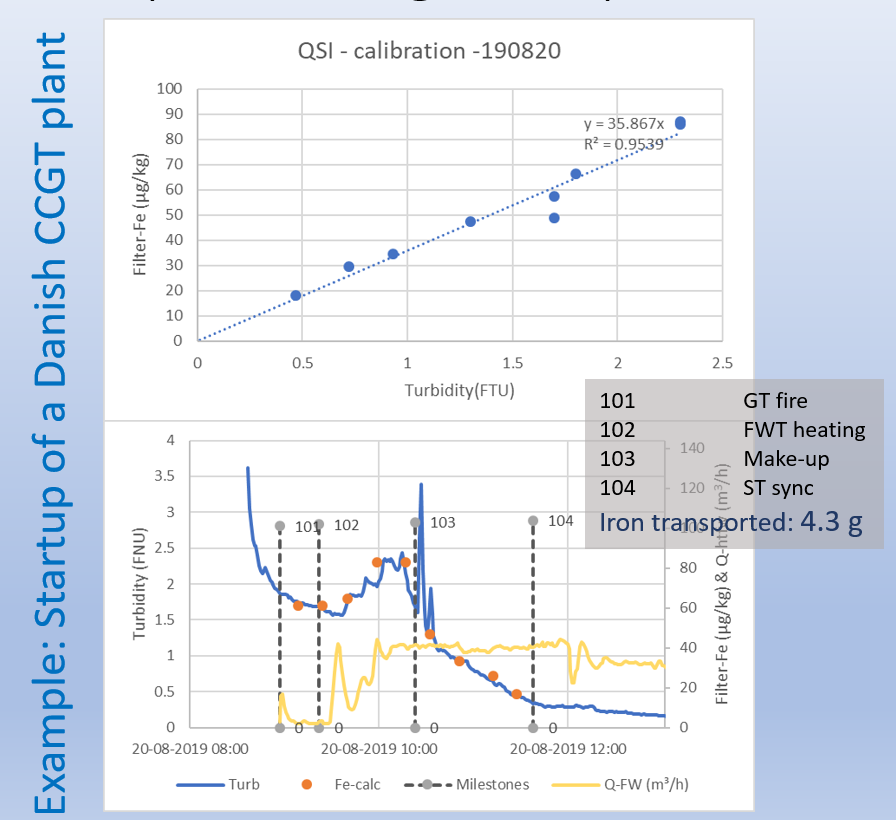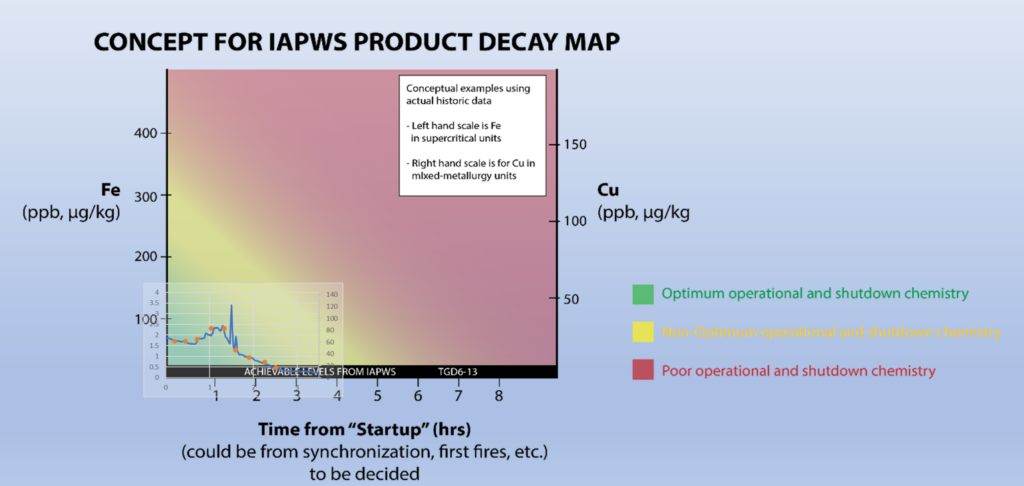Main purpose: Inclusion of a Round Robin for Corrosion Products within the IAPWS International Collaborative Project to Develop and Fine Tune the IAPWS Decay Map
The current IAPWS TGD, TGD6-13(2014), for corrosion products sampling and analysis calls for steady, high load operation during sampling. Results obtained under those conditions depict the level of ongoing corrosion, which may be compared at different plants with different chemistries. However, the steady condition for sampling is rarely met for a large number of plants, since the load cycles continuously or they run on a “stop & go” scheme. Measuring corrosion products and interpreting the results for such flexible plants presents a challenge; this was the starting point for the revision of the TGD that started in 2015 shortly after the current version was published. During this work we have realized several main points:
- The major part of corrosion products are transported during transient load, not during steady load conditions. This means that results obtained under the classical sampling conditions grossly underestimate the amount of corrosion products transported to boiler/evaporator and thus the growth rate of the insulating oxide layer on the tubes. When inspecting tube samples this may lead to the unexpected conclusion that the boiler needs chemical cleaning , even if iron levels in the feedwater have been low and well within IAPWS TGD guiding values.
- Corrosion product transport may be measured reliably by on-line proxy methods, e.g. turbidity or particle counters, and these particle-sensing methods correlate well with corrosion products collected on membrane filters (called Filter-Fe). This statement is only valid when correct sampling conditions are provided, i.e. turbulent flow conditions all through the sampling line, flow division just ahead of the monitor, and – for the last short distance – a constant head flow suited for the monitor.
- The proxy methods allow estimation of the mass transported in feedwater and condensate during transient load conditions or even startup. This is done by integrating the product of iron level and flow across the relevant time slot. The iron level is obtained from the relation between proxy signal and Filter-Fe.
- Measurement of transported mass and the decay rate of corrosions products in feed water during startup is a practical tool to assess the efficacy of the preservation measures used in the previous shutdown period. By repeated application, this tool may be used to optimize preservation measures as the effect of changes in the procedure is assessed quantitatively.
These major findings and how to apply the methods are described in a White Paper (pre-TGD) summing up the current state. This also outlines how the methods may be used for optimizing preservation by systematic monitoring of corrosion product transport during startup.
Necessary actions to finalize the TGD
To finish the TGD, IAPWS needs to collect experience from many startups monitored at different plant types with different chemistries and preservation methods. IAPWS is most interested in plants with all-ferrous and mixed-metallurgy feedwater systems as this will allow IAPWS to calibrate the Corrosion Product Decay Map (IAPWS Decay Map in short) for total iron and copper in terms of operation and shutdown practices. This Decay Map is thus a convenient tool to grade and optimize the results obtained during startup by the methods described in the White Paper (Pre-TGD).


IAPWS wishes to continue plant monitoring and has initiated a second International Collaborative Project to fine tune the Decay Map. IAPWS invites you to take part and volunteer your all-ferrous or mixed-metallurgy plant. This series of monitoring will include an IAPWS-organized round robin on corrosion product analysis involving both measurement of total iron in grab samples (as per the current IAPWS TGD) and corrosion products on membrane filters (Filter-Fe). Of course if a mixed-metallurgy plant is volunteered, then copper will also be monitored. The Filter-Fe method basically consist of digesting corrosion product caught on a membrane filter and then analyze the digest as usual. Thus, it is easily adapted to the current method used at a plant (spectrophotometric or ICP), and instructions to do so are available. Most likely, the filter method is applicable for copper corrosion products as well. However, the correlation between the proxy methods and copper levels has not been investigated in the previous IAPWS project, but responses related to both iron and copper levels must be expected. The round robin focuses only on iron, because there is sufficient experience with the Filter-Fe method to expect a successful outcome, i.e. the method is fit for purpose. If mixed-metallurgy plants are volunteered for the Collaboration Project, parallel analyses of Filter-Cu may be arranged to ensure comparable results.
The IAPWS Round Robin
The purposes of the round robin are:
- To demonstrate that the Filter-Fe method is suited as a standard for widespread use, i.e. power plant laboratories are able to use it according to the instructions and obtain consistent and comparable results.
- Provide the participants with the opportunity to test the Filter-Fe method and compare results with the group of laboratories taking part. In the same round the classical grab sample analysis for total-Fe is tested and the results compared. Both serve to qualify the laboratory for present and future work at the plants.
- Provide the analytical base for the collection of experience mentioned above. If there isinterest in taking part in the IAPWS Collaborative Project, then IAPWS suggests participation in the round robin as well. This will improve the quality of data available for the final grading of the IAPWS Decay Map, since data are comparable from the analytical perspective.
In short, by taking part in the round robin, you will get:
- Instructions and guidance on how to implement the Filter-Fe method in the plant’s lab.
- Verify both the new and the current routine method for iron by comparing the results to those of the group of competent laboratories.
- Provide the best starting point for taking part in the data collection to finalize the IAPWS Decay Map in the fall of 2022 and first part of 2023. By doing that, plants will learn the methods for assessing preservation measures and investigating operational chemistry for condensate, feedwater, and boilers.
A similar round robin was conducted in 2018/19 by Maja Skou Jensen as part of an IAPWS International Collaboration Project and later reported in Power Plant Chemistry (PPCHEM, 2019(04), p. 218-229). Here, the participating laboratories as a group succeeded in getting comparable results with both methods as shown in the figure below.

The results are normally distributed on a log-axis and this gives rise to the rather broad confidence intervals shown in the figure.
The round robin will be organized as follows:
- We will prepare a number of identical sample sets corresponding to the number of participants plus extra sets for homogeneity test. We expect to have the samples ready by the end of August 2022.
- Each set will consist of 3-4 grab samples (100 mL in HDPE bottles) from boilers in operation and 3-4 membrane filters with corrosion products obtained by filtering 1 L of sample from the same sampling points. Grab samples and samples for filtration will be taken intermittently to make them as equal as possible. Additionally, the set will contain 2 synthetic samples (QC-standards) so that the performance of the analytical method applied can be evaluated separately.
- Each participant will receive a set of samples, instructions for taking part and for the Filter-Fe method as well as an Excel form for data submission. Distribution will be announced, so the participant will know when to expect the samples, and the measurements should be done and submitted within two weeks after receival. Distribution is expected early September 2022 and results must be submitted late September 2022.
- We will treat the submitted results statistically according to the standard ISO 13528:2015 and report both the performance of the group and of the participants individually. The participating laboratories will be given an ID and cannot be identified directly. The participants will be informed of their ID individually. The report is expected to be sent out in October 2022.
- The outcome of the round robin will be used for further evaluation by the TGD task group and may be presented or published in relation to that.
There is quite a bit of work to do and expenses to be covered in preparing the samples, testing homogeneity, distributing sample sets, data processing, and reporting. This is on a non-profit basis. IAPWS will cover these costs along with any shipping charges.
Conditions for participation
- Registration: Send an e-mail to Karsten Thomsen, COWI, knth@cowi.com, mobile phone: +45 2787 5744, with information on contact data (name, mail, phone) for your person in charge and shipping address for samples.
- Registration by 15 August 2022 latest.
- Data submission is due latest by 1 October 2022.
- A plant is welcome to take part in the round robin, even if staff is not able to contribute in the later stage. However, those that contribute to the collections of startup data will have priority, if the number of participants should exceed 30.